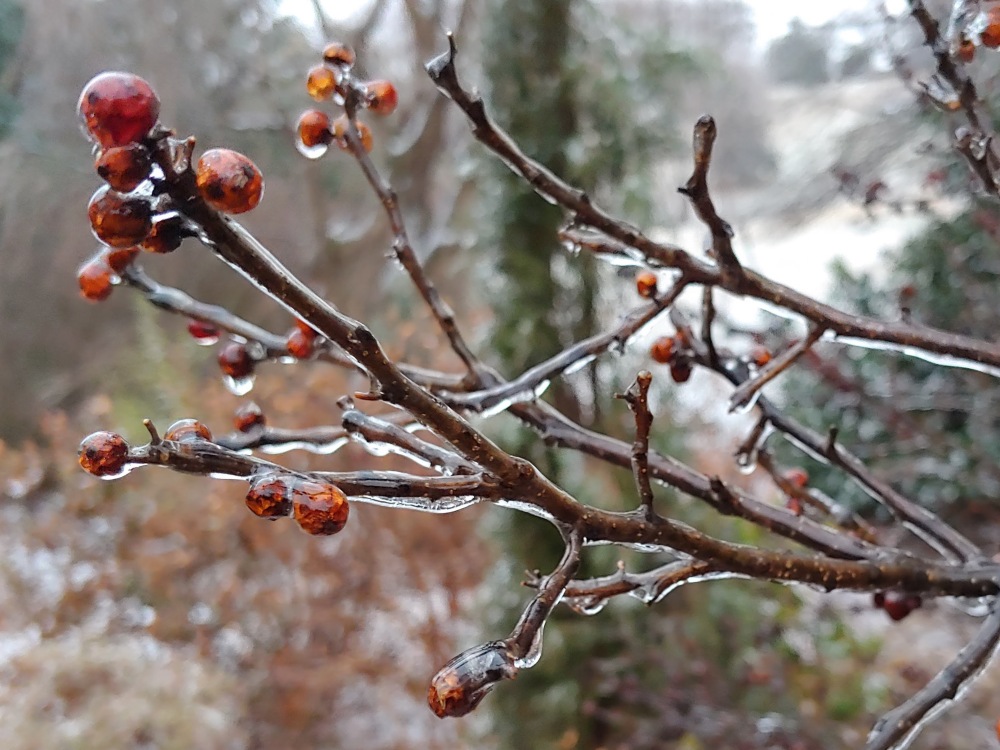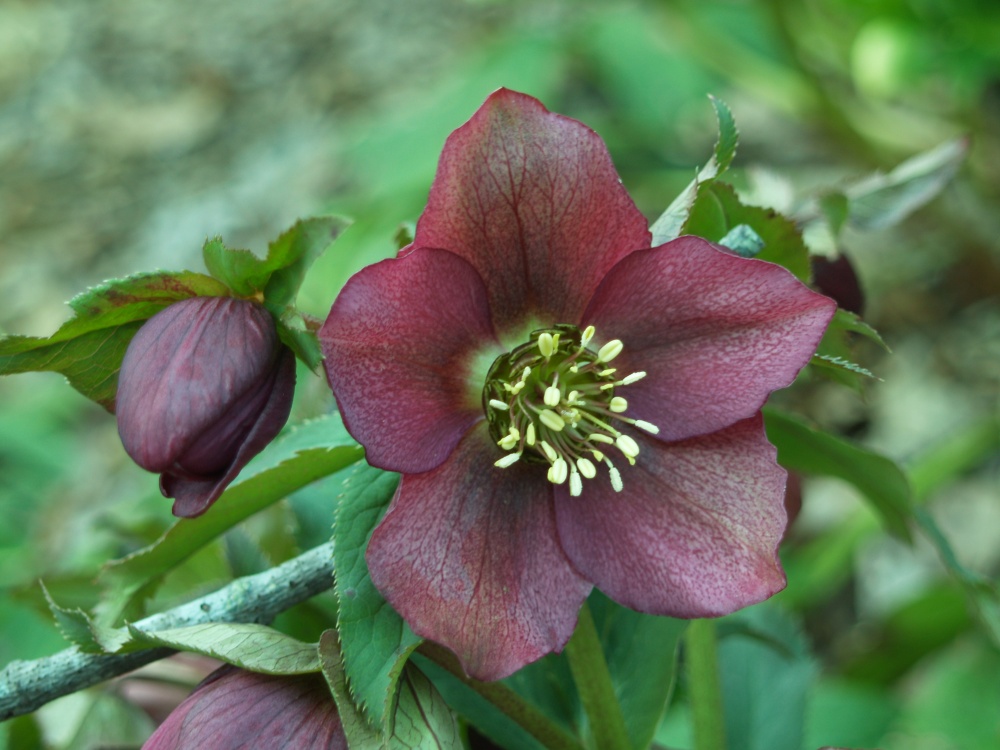I don’t believe it’s possible for the lower half of the garden to be any soupier than it is today. The repeated cycle of freezing and thawing opens air pockets in the soil that are now filled with moisture from recent snow, ice, and rain so that every step in the back lawn leaves a depression several inches deep. The lower garden was very damp for much of last year, but for a short while I must stay out as much as possible to keep from destroying what little lawn remains. It seems impossible that this year could be as wet as last, but today, it’s not looking good.
 Recent turns from frigid to mild temperatures, followed by ice (above), snow, and everything possible in between, are not unusual, and are hardly a bother except that the gardener was teased with spring-like temperatures a week ago. And then the weather turned. For the worse, if that’s possible. Not so cold, but more miserable. For two days, I didn’t step outside for a moment.
Recent turns from frigid to mild temperatures, followed by ice (above), snow, and everything possible in between, are not unusual, and are hardly a bother except that the gardener was teased with spring-like temperatures a week ago. And then the weather turned. For the worse, if that’s possible. Not so cold, but more miserable. For two days, I didn’t step outside for a moment.
Better days are on the way, and with any luck the mildest days will not be accompanied by rain showers so a bit of work can be done to lessen the March workload. The most immediate task is to cut browned leaves off hellebores. Fortunately, I can get away without cutting every hellebore. Some fared better through the freeze than others, and if the leaves aren’t too bad off, and if the flowers are ones that stand taller there will be no need to cut anything. I figure it’s about half of the fifty or more hellebores that must be chopped, and soon, since buds are swelling quickly.
I despise garden to-do lists and never pay them a moment’s notice unless the chore is something that I absolutely know needs to be done, which are hardly any. So, if you have hellebores with browned leaves, and the flower buds are nestled under the leaves so you can’t see them, cut them off. If the leaves aren’t bad, and the flowers stand up, don’t worry about it until later, and possibly new growth will cover the old leaves and you won’t have to do this until next year. Things I can put off until next year, that’s my kind of to-do list.
What do you do with the cut browned hellebore leaves? Do you leave it there as “mulch” or do you remove it? If the latter, do you add anything as “mulch”?
The hellebore leaves take forever to decay, so they’re tossed into the brush pile, where eventually they go away. Planting areas in this garden are not tidy, so leaves and debris from pruning are usually left where they fall. When I first plant a new area, I mulch with bark nuggets that are slow to decay, though they are slowly washed away. Then, I never mulch again. In the large wooded areas I shred leaves, or just let them decay in place, but these areas were never mulched other than with leaves.
Since the garden is planted primarily with trees and shrubs, with perennials filling between, the plan is to have everything grow together so weeds are not a problem. Mostly, this works, though weeds growing at the edges of planting beds are still a problem.
If the hellebore leaves are still green, shall I just leave them alone, or is “chopping” of ALL leaves required to generate new growth? Also, my 6 hellebore plants are mostly in deep shade, and mostly bloom every winter/spring. But they don’t seem to spread by reseeding. They’re in forested areas with lots of leaves on the ground. Shall I keep the leaves raked away so they’ll re-seed? When do they reseed? Thanks. Enjoy all your posts. (We live two counties east of you)
It is not necessary to remove leaves. Several of the oldest hellebores I have get very bushy, and with flowers on short stalks the blooms are barely visible if leaves are not removed. This variety is also most susceptible to leaves browning in very cold temperatures. Newer hybrids suffer less foliage damage, and flowers usually rise above the foliage, so cutting back is not necessary every year. With leaves pruned off, or not, this does not effect new growth.
As for seeding, the older types are the ones that seed prolifically. Many newer ones do not seed at all, and I read that many hybrids are sterile, so they will not seed. So, I doubt if the lack of seedlings is the result of leaves not being cut. I have so many tiny seedlings that I’ve never paid attention to when the seedlings appear. I usually remove excess seedlings after the first year, so today there are one and two year old seedlings. Sometime, I suspect by late spring, the next batch will appear.
Dave….My question about “leaves” was garbled. I’ll try again. If I rake away the thick covering of tree leaves which are always on the ground, will my helebores have a better chance of re-seeding, as they do not seem to be doing so now? Can I tell if my hellebores are sterile or not?
A cover of leaves should not be a problem that prevents hellebore seeds from reaching the soil, and then germinating. I suspect the reason they’re not seeding is that they’re sterile. I’ve Googled a few of my newer varieties, and found sites that explain the crosses involved in the hybrid, and also indicated that these were sterile. I think the information on individual hellebores will be found only by searching the name, and then looking for sites that are not just the simple listings of flower color, etc. There are often pages from the breeders of specific groups of hellebores that give this kind of information.
I love the icy branches picture – wonderful!
Cheers, 🙂
Hellebores do not cooperate for me anyway. We grew them years ago because clients wanted them. I work with them in landscapes now, and find that they do not better than they did on the farm. I really do not know what they dislike here. I do not think they need a chill.